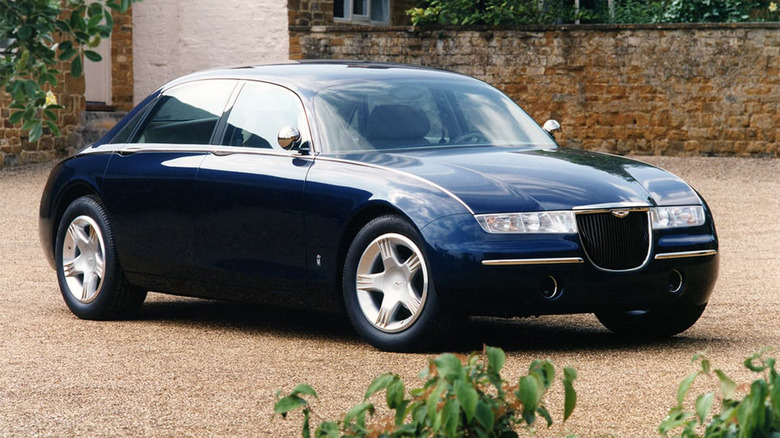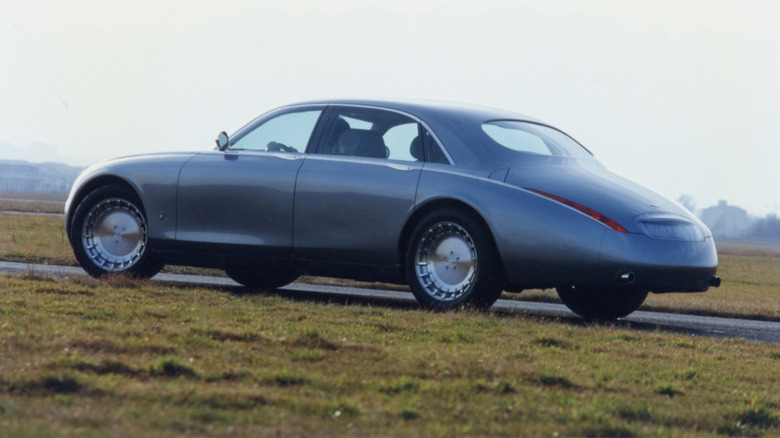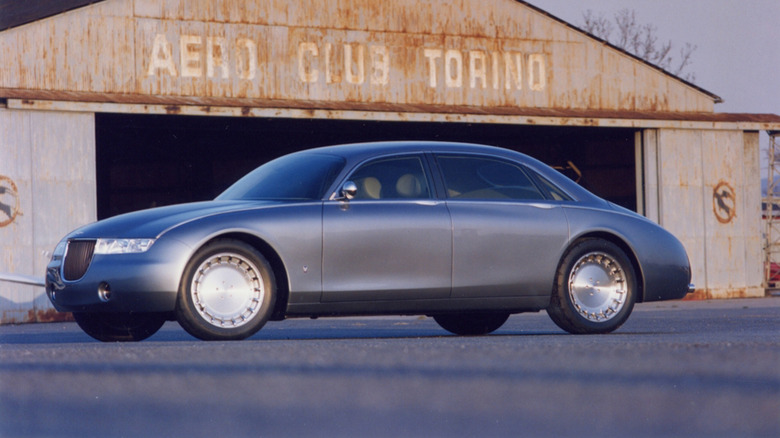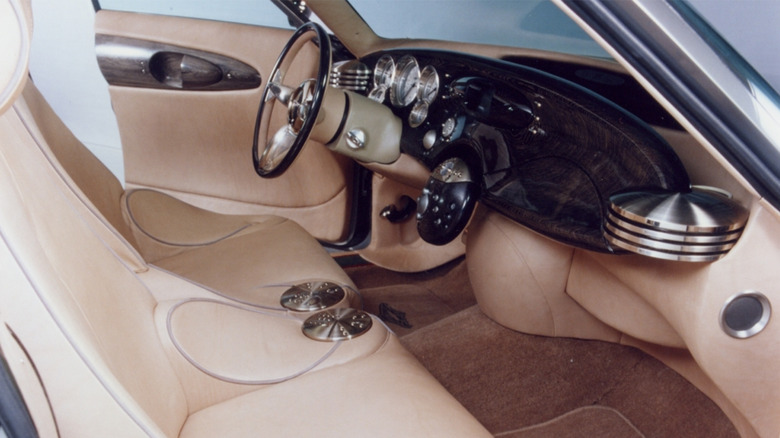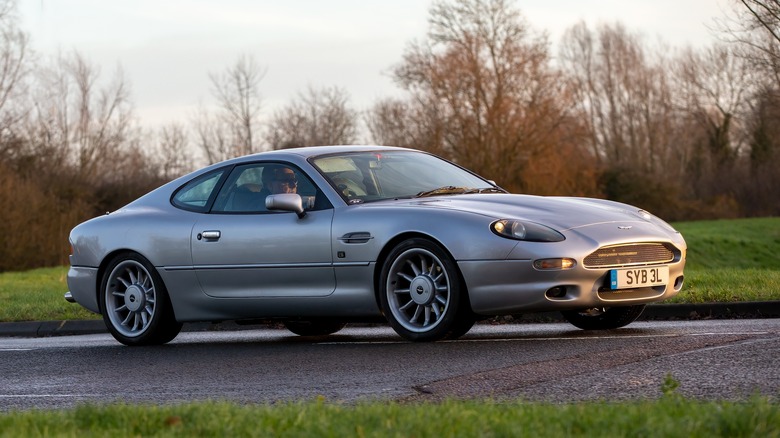The 1993 Aston Martin Concept Car Perfect For Any James Bond Villain
From Goldfinger's Rolls-Royce and Mr. Hinx's Jaguar C-X75 to henchmen in Range Rover SVRs and Land Rover Defenders, the bad guys' cars are as crucial to any James Bond film as 007's DB5. His enemies have often mimicked Bond in their choice of British cars, but so far, no baddie has also driven an Aston Martin. Though what if they did? And what if this particular bad guy fancied a one-off, retro-styled sedan from the '90s? We're the first to admit this is all a bit niche, but we also think we've found the perfect Aston Martin for Bond's next nemesis.
Called the Lagonda Vignale, this particular car was a concept designed for Aston by Ghia and revealed alongside the DB7 in 1993. A four-door sedan with retro styling cues and an unusual interior, the car was intended to have a V12 engine. But it failed to reach mass production, and only three were ever produced.
Although perhaps not a car to engage in a gun-blazing, high-speed chase with Bond, we can picture a villain being chauffeured in the back of their Lagonda Vignale, quietly plotting world domination as they slip through city traffic, headed for an Alpine pass.
Geneva 1993
Our story begins on March 2, 1993, at the Geneva Motor Show, where Aston Martin featured a pair of cars designed by two Scottish brothers. On one side, there was what eventually became the DB7, a car conceived by Ian Callum and often credited with saving Aston Martin from bankruptcy. Next to it sat the Lagonda Vignale, designed by Ian's younger brother Moray, says TopGear.
While Ian worked at Aston Martin, then owned by Ford, Moray was employed by Ford's Ghia Design Studio in Turin, Italy. Moray was tasked with designing a saloon/limousine that could borrow from Ford's upcoming revival of the Lincoln Town Car, says David Dowsey in his 2007 book Aston Martin: Power, Beauty and Soul (page 116). The car would also serve to relaunch the Lagonda brand, which was founded in 1906 and purchased by former Aston Martin owner David Brown in 1947 but had predominantly laid dormant since the 1970s.
Beyond the year 2000
The Lagonda Vignale and the relaunch of the Lagonda brand was a forward-looking moment for Aston Martin. The company described the project in a press release that can be seen in a 2008 Bonhams auction listing as: "...a design study for a concept vehicle to investigate and research the materials and techniques which would justify the continued production of the hand-made luxury car beyond the year 2000." Aston Martin also presented the car as a "no-compromise, full-size, high-performance, four-door luxury saloon in the classic Grand Touring tradition."
The show car had a 4.6-liter Ford V8 engine producing 193 horsepower and 260 lb-ft of torque, says TopGear. But had the car gone into production, it would have used a 400-horsepower, 5.9-liter V12 eventually used by the Aston Martin Vanquish – also designed by Ian Callum and James Bond's car of choice in 2002's Die Another Day.
David Dowsey says that the plan was for half the V12's cylinders to shut down when not needed, such as in heavy traffic or under light load, to lower emissions and improve fuel economy. The projected top speed was 150 mph.
Futuristic interior
Cream leather, chrome, white dials, and a thin-rimmed steering wheel tell the story of an Art Deco cabin modernized for the mid-1990s. The dashboard, pedals, and wheel featured extensive nickel plating, says David Dowsey, while the dashboard was made from a single piece of laminated beech wood.
According to a Discovery documentary about Lagonda — and in what must have felt thoroughly futuristic at the time — the concept featured an integrated satellite navigation system and built-in laptop computers for rear passengers (or Bond villains) to work on. A final flourish saw the car's steering wheel move out of the way when the driver's door was opened.
Although it would surely have been toned down for a production version, the concept's retro interior details are reminiscent of the Jaguar S-Type that arrived in 1999. At the time, both Jaguar and Aston Martin (as well as Land Rover, Lincoln, and Volvo) were part of the Ford-owned Premier Automotive Group.
Just one customer car
Unfortunately for the Lagonda, Aston Martin decided to produce the DB7, pictured above, instead. David Dowsey quotes former Aston Martin chief executive Bob Dover as saying the Vignale Lagonda was "a blind alley" due to customer unfamiliarity with the Lagonda brand outside of England.
Ford produced two show cars, one used for PR duties before being scrapped, as reported in issue 21 of the Aston Martin Heritage Trust annual. The other, the original Geneva motor show car, was kept by Ford until it was auctioned by Christie's in 2002. The car shot past its $60,000 to $120,000 estimate, selling for $403,500.
A third Viganle, painted metallic burgundy and the only example to feature a V12 engine, was hand-built by Aston Martin in 1995, writes Dowsey. The car was built on a different platform to the show cars and featured larger headlights, a more prominent grille, separate front turn signals, and a reshaped air intake. The door mirrors and alloy wheels were also different from those of the show cars, while the left-hand-drive interior retained the Art Deco original look, albeit toned down and with a more traditional center console.
Known as DP2138, the one-off Lagonda Vignale was sold to a collector in the Far East for 1.3 million pounds, says Dowsey and the Aston Martin Heritage Trust magazine. TopGear says the collector was the Sultan of Brunei, who purchased many bespoke and limited-edition cars throughout the 1990s.
